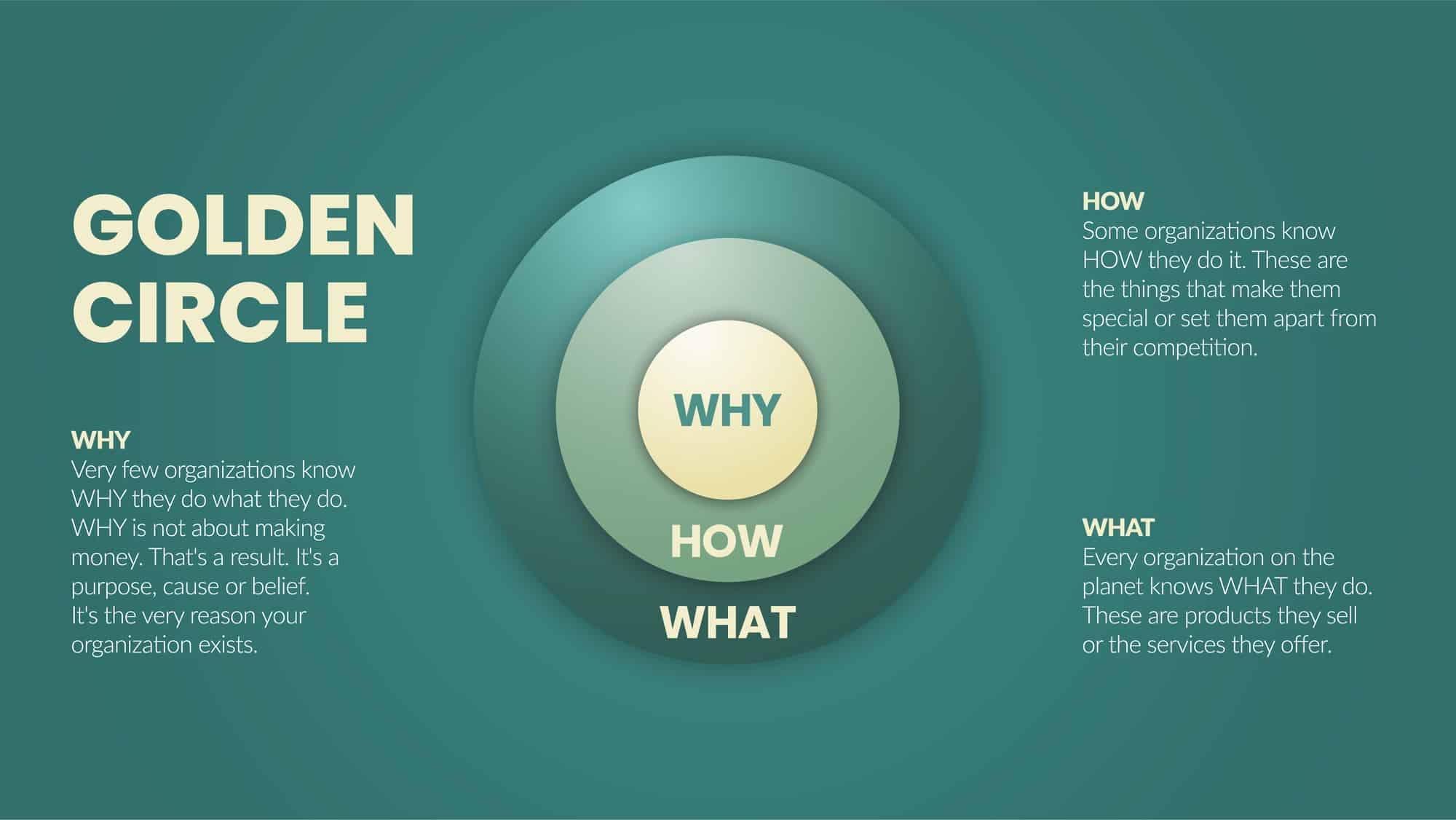Every organization wants to succeed and have a vast customer base, but in most cases, they've got their basics wrong. That's why they can't succeed.
In today's article, we will discuss those few factors upon which organizations need to focus on becoming the market leader.
You must be thinking that there would be so many things that need to be corrected to succeed, but what if I tell you that if you only focus on three questions: Why? How? What? You can make your organization succeed by answering those.
A learned author, Simon Sinek, developed a theory called the golden circle theory. According to this theory, some organizations manage to become significant. In contrast, others fail because the organizations that do well focus on three questions: Why, How, and What.
https://www.youtube.com/watch?v=qp0HIF3SfI4
Before we further explain these three factors in detail, you should know that the Why, How, What analysis is the business tool used to analyze how much importance an organization has given to these factors.
Now let's get back to Simon Sinek's theory, which explains that a business must focus on the question "Why." Simon Sinek believes that every successful business knows why it is operating. Therefore, the factor "why" in the golden circle theory represents the purpose of the existence of a company.
Then after defining it, Simon believes that successful organizations focus on their "How." According to the theory, the word "how" represents how organizations can achieve their purpose of existence.
However, the last word, "What," in theory, is least focused upon by successful organizations. Instead, this factor focuses on the product or service the organization delivers to its consumer.
According to the theory, the businesses left behind have their priorities 180 degrees different from successful organizations.
Simon states that unsuccessful organizations focus the most on what they are producing. After that, they focus on how the operations are carried out. Finally, the most minor importance is given to why the vision of the organization.
Businesses use the why, how, what analysis to see the priorities of their and other organizations. This analysis can help us see where an organization is going wrong. For example, suppose, according to the analysis, an organization prioritizes the other two factors more than why. In that case, it needs to reset its policies and framework.

How to Conduct a Why, How, What Analysis
We have discussed the significance of the why, how, and what analysis. In the previous section, we also discussed why we use it. This section will look into how to conduct the why, how, and what analysis.
Why
In the golden circle theory, Simon has given the most importance to the factor "why." He believes that an organization needs to tell its buyers the reason why the organization is operating.
According to Simon, the purpose or vision of an organization drives buyers to become loyal customers.
The golden circle theory suggests that buyers are not very interested in the products offered by organizations. However, they're interested in the question, "Why are you into this business?"
The first step of conducting the why, how, what analysis is to identify the why. For example, if you are conducting an organization's analysis, first look at whether it has identified its purpose, mission, and vision clearly or not.
How
The factor that Simon found second most important in the success of an organization was the "how" factor. This factor indicates the methods adopted by an organization to achieve its purpose and mission.
This factor is named by Simon since it answers questions like "how is an organization different from its competitor?" and "how do they operate?"
Analyzing the "how" of an organization is the second step of conducting the why, how, what analysis.
What
The last factor that plays an essential role in an organization's success is referred to as "what" by the golden circle theory.
According to the theory, after the organization has sorted out its why and how factors, that's when it should mention and pay attention to what product it is offering.
The features and the nature of the product are given the most minor importance by Simon. However, to conduct a why, how, what analysis, it is essential to analyze all three factors responsible for an organization's success.

Advantages of Using the Why, How, What Analysis
Now that we have discussed the significance of the three factors that determine the success of a business and how to conduct the why, how, and what analysis to analyze these three factors of an organization.
This section will discuss the advantages of using the why, how, and what analysis you've learned to conduct in the previous section.
Sets Direction for the Business
Once you understand your company's why, how, and what, you'll be able to create a vision that inspires and guides all aspects of the business. Take some time to identify those answers and figure out how they help populate your plan with the right tools and changes that are likely needed to achieve your goals.
The golden circle gives you a structure for creating content that encapsulates and champions the brand's core values.
Differentiates the Organisation From Competitors
Organisations use why, how, what analysis for self-assessments. For example, the golden circle theory helps companies understand how to build a brand that will stand out and make people want to work for the company again and again.
Following the golden circle will help you build a loyal following of customers who want the same things as you, ensuring your message is never lost in the noise.
Gives a Reality Check
Many organizations conduct the why, how, what analysis after a certain period to see if they have deviated from the fundamental goals, vision, mission, etc.
It is common for organizations to deviate from their why, how, and what with time. Hence, organizations use the analysis as a reality check to see if they're on the right track.
How Can Businesses Use Why, How What Analysis for Their Own Benefit
The why, how, and what analysis is famous for providing beneficial outcomes to businesses. However, businesses look forward to analyzing their marketing and sales policies.
This section will discuss how conducting a why, how, what analysis can benefit the organization.
Make New Policies
Organizations look forward to the why, how, what analysis since they know it is very significant. Then, companies conduct the analysis and obtain the results.
According to these results, organizations draft their policies ahead. So, for example, if an organization's why, how, what analysis indicates that it is not highlighting any of the factors correctly, then the organization would have to draft new policies to explain its why, how, and what in a better way.
Tells About the Competitors
Organizations often run a why, how, what analysis on their competitors to see where they are weak. Then after looking at the weaknesses of their competitors, they plan to exploit them.
Moreover, analyzing the competitor's strategies helps the organizations to frame their own why, how, and what strategies accordingly.
Identification of the Reason for Failure
The theory of the golden circle states that if an organization doesn't have the right why's, how's and whats, then such business can't succeed.
However, an unsuccessful business can run the why, how, what analysis to detect the exact cause of its failure. If the exact cause is detected, it is possible that after correcting the problem, the organization begins to function correctly.
Why, How What Analysis Case Study
We have been discussing throughout the article that according to the golden circle theory, the "why" factor of the organization holds the most significance. But, on the other hand, how and what factors hold less significance in the eyes of the customer.
Here we have a case study that proves the claims of the golden circle theory. The following case study shows how Amazon has proved all three factors' significance.
AMAZON
Amazon has always worked to improve the experience of customers who shop with them. The company's Golden Circle brand is centered on this customer-centric philosophy, which ensures that everyone using the site or app sees and feels like they are a member of Amazon's family.
Amazon is an online retail giant. Not only does Amazon sell books, electronics, and home goods the way it's always done, but it's bringing in a new set of customers and finding new ways to sell those products. The company has achieved this by creating a platform that allows customers to discover and buy everything they need.
However, the "what" of Amazon isn't much highlighted by the company compared to the "how" and "why."
Despite being the most prominent e-commerce platform today, the way it accommodates and facilitates its customers is something that helps it grow. Moreover, one of the big reasons for the success of Amazon is its commitment to its core values and high motivation.
All the major big organizations that dominate the markets all across the globe have one thing in common, and that is the implementation of the golden circle theory.
TESLA
Besides Amazon, Tesla also proves the theory of the golden circle correct. Tesla is one of the companies that give the most importance to its "why." Tesla clearly states its "why" everywhere, and that's what it's known for.
You must be thinking about Tesla's" why." Its mission is to transform the transportation sector by using clean energy. Tesla gives the most significant importance to its mission of clean energy consumption.
Moreover, Tesla has also clearly defined its "How." Everyone knows that such a significant transformation in the transportation sector is only possible through clean, renewable energy consumption instead of fossil fuel.
Moreover, its "what" is also evident that it would be the electric vehicles that Tesla manufactures to accomplish its goals.

Final Word: Why, How, What Analysis
Finally, we have reached the last section of this article so let us just recap whatever we have discussed.
This article was about the why, how, and what analysis. To summarise, these three factors are considered responsible for the success of an organization, according to an author named Simon Sinek and his theory of the golden circle.
He provided guidelines to the organizations on what they must do to become successful. According to his guidelines, less successful companies must prioritize their "why" to become great. The "why" factor of the why, how, and what analysis represents the organization's vision and purpose.
Moreover, the theory also states that the "how" factor is also essential as it represents the method and measures taken by the organization to achieve its mission.
However, the last factor mentioned in the golden circle theory, "what," is the least important factor, and less importance should be given to this factor. This factor represents the product offered by the company that will help the organization achieve its mission.
Other than that, we also discussed how to construct the why, how, what analysis. Like any other business tool, it has significant advantages for the business.
Moreover, we also highlighted the benefits businesses can obtain by using the analysis of why, how, and what. In the end, we discussed two case studies of Amazon and Tesla. Both are the leading companies at the moment, and they have their why's, how's and what's aligned as per the golden circle theory.
We assume you would have enjoyed reading this article as it has made you aware of the why, how, and what analysis.








